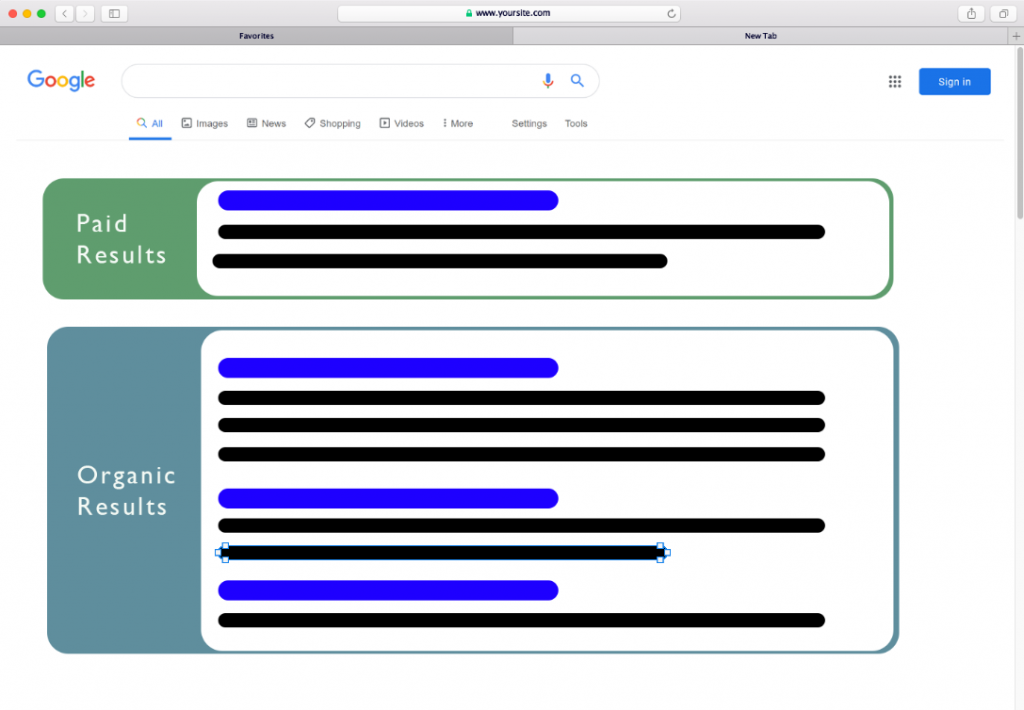First off, SEM vs SEO, what do those acronyms mean?
SEM – is Search engine marketing. It is a form of Internet marketing that involves promoting websites by increasing their visibility in search engine results pages primarily through paid advertising.
SEO – is Search Engine Optimization. It is the process of improving the quality and quantity of website traffic to a website or a web page from search engines. SEO targets unpaid traffic rather than direct traffic or paid traffic.
SEM vs SEO What is the critical difference?
While closely related, there is one key difference, SEM is a paid advertising strategy, and SEO is an earned (organic) strategy. Overall, the relationship is much like Advertising vs PR.
To fully understand the difference between SEM and SEO we need to understand paid vs organic search results. The image below outlines the structure of a Google search result. The ads or paid results are at the top, and earned or organic results at the bottom of the page.

SEM
The key element of SEM is using paid ads to increase a website’s visibility. Your advertisement appears on the search engine results page when a user makes a related search by bidding on specific keywords, phrases, and terms.
Benefits:
- You can see almost immediate returns. An extremely basic campaign can be completed and turned on within minutes. Theoretically driving customers within an hour.
- You can control what ad Google shows– you write the ad copy. Unless you are dynamically generating ads, Google will only show the copy you crafted in the text ad.
- You can control when your ads appear- If you are a shoe store, your ads can be sandals related in the summer and boot related in winter. Being more targeted can help separate you from your competition
- It’s easy to test and refine – You can see detailed metrics on how your ads performed, including what keywords performed best and drove the highest ROI. It is also a breeze to A/B test your text ads.
Negatives:
- You pay for every single click – Each visitor comes with a cost whether or not they purchased from you. Over time the costs of these clicks add up. This is especially true if the campaign is not optimized correctly. You can end up paying too much per click.
- It’s not set and forget – you need to continually monitor your keyword lists to make sure you aren’t paying for clicks you don’t want. Professional management is where a trustworthy agency can be of benefit. They can use their experience to manage these accounts efficiently and continuously improve their performance.
- The customer knows they are clicking on an ad – there is an Ad icon before every text ad.
SEO
Ultimately, any search engine’s goal is to drive you to the most relevant pages that meet your search.
As time has passed, these search engines have evolved and become smarter. Just because your site is stuffed with as many keywords as possible, that won’t get you to the top of the search results pages anymore. You need to use solid SEO strategies if you want to rank on the top page of competitive searches.
Benefits:
- Better conversion rates – by implementing solid SEO practices, visitors will have an easier time navigating your site and getting what they want. Optimized sites help to turn visitors into customers.
- Can save you money – while good SEO isn’t free, it does allow you not to buy as many keywords when doing SEM.
- Builds brand credibility – The consumer trusts the search engine and naturally thinks that the companies at the top of the search page are likely the biggest and best.
- SEO gets more clicks than SEM – The first organic result in Google Search has an average click-through rate of 28.5% . According to Wordstream, the average SEM campaign produces a CTR of 3.17%.
Negatives:
- Nothing is guaranteed – SEO is a series of best practices, but at the end of the day it all depends on the search engine’s algorithm. Especially in a competitive field, there is a chance that your competition is better at SEO.
- Results are not instantaneous – Good SEO takes time. While some aspects like cleaning up (or creating) Google My Business pages may provide quick results, other tasks can take months to bear fruit.
- It can be expensive – Good SEO work means constant work. Most elements aren’t set and forget. Your site needs regular updates, like blog posts. There is a great deal of copywriting and keyword research.
- There are many shady vendors – Unlike SEM where you can see metrics on return on investment. Many SEO unqualified SEO vendors hide behind complex reports that tout impressions and search rankings on cherry-picked keywords. Outside of maybe a blog post, they don’t provide any real proof of the work that they provide. Look for a vendor that logs their work and provides a dedicated number of hours doing on-site and content SEO every month.
SEM vs SEO – What do they both do:
Campaigns of both strategies do the following:
- Provide more traffic – both disciplines, when properly utilized, drive more visitors to your website.
- Provide better quality traffic – Because so much is based on specific keywords, the new visitors to your site are most likely to be interested in the goods/services you provide. Over time you will see less general traffic that doesn’t convert.
Final Word:
It doesn’t have to be just SEM vs SEO, most websites can benefit from a combination of SEM and SEO. They work together very well, and sites that implement both are often the most successful. But we realize that budget doesn’t always allow the best-case scenario, so hopefully, this post helped you decide which direction you want to go first after evaluating your digital goals. If you are still confused about which strategy (SEM vs SEO) your website needs after this article, please reach out for our consultation services.


